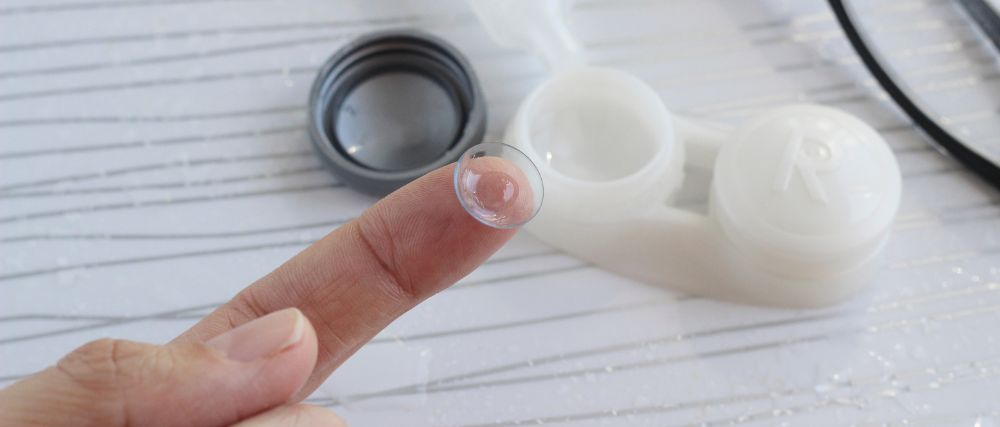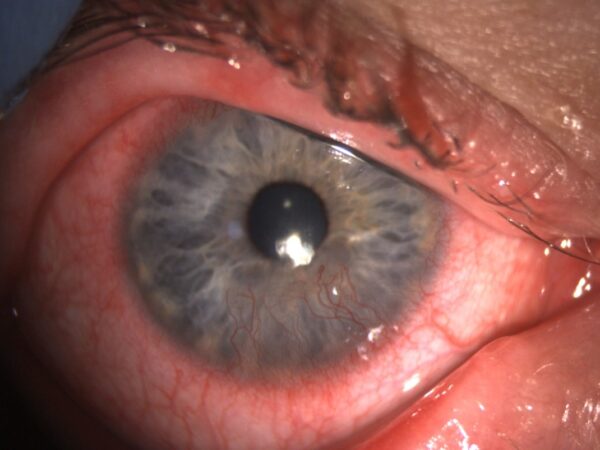Surgical management of raised intraocular pressure post EyeCee One intraocular lens implantation
Patient presentation / Diagnostic testing
A Caucasian patient in her 60s presented with an acute intraocular pressure (IOP) spike in her right eye one day post phacoemulsification cataract surgery with EyeCee One intraocular lens (IOL) implantation on 24 January 2023.
Medicine and Healthcare products Regulatory Agency (MHRA) issued a Device Safety Information (DSI) notification (DSI/2023/001) on 26 January 2023 regarding reported cases of increased IOP in patients who received implantation of EyeCee One preloaded IOLs (manufactured by Nidek, Japan and distributed by Bausch & Lomb UK Ltd) and instructed all eye centres in the UK to stop using and to quarantine these products (1).
The surgery for this patient took place 2 days prior to MHRA notification on EyeCee One IOL withdrawal.
This patient had a history of ocular hypertension (OHT) and narrow angles and received bilateral YAG peripheral iridotomy 6 years prior. She used multiple anti-glaucoma topical drops including latanoprost, ganfort and cosopt over the years but was intolerant. She complied with timolol preservative free single unit drop but her IOP was uncontrolled with IOP near 30mmHg in the right eye. Both eye visual field test was unreliable but appeared to show mild field defect in the right eye. There was also evidence of retinal nerve fibre layer thinning in the right eye with interval changes on OCT of the disc.
Her pre-operative visual acuity was LogMAR 0.3 for the right eye and 0.2 for the left eye.
It was decided to proceed cataract surgery for her right eye to better control her IOP.
From her biometry, her axial length was 21.66mm and anterior chamber depth was 2.14mm. She received EyeCee One IOL of +30.00 diopter. Cataract surgery went uneventfully with no complications.
Diagnosis and Management
On day 1 post op, her IOP spiked to 80mmHg and the emergency management initially included intravenous acetazolamide, mannitol infusion and topical anti-glaucoma medications but raised IOP was unresponsive then proceeded to slit lamp wound burping which lowered IOP temporarily. IOP was raised again on day 2 post op and urgent anterior chamber washout was arranged on the same day. There was no obvious viscoelastics noted during the operation and the eye was left relatively soft at the end with 10/0 nylon suturing the main corneal incision.
Follow-up
The patient returned to the clinic on day 3 post op (27 January 2023). Patient’s intraocular pressure was 44mmHg despite anterior chamber washout. Duty of candour regarding MHRA DSI notification regarding EyeCee One IOL withdrawal was explained to the patient. Medical management for raised IOP continued whilst having multidisciplinary team discussion among glaucoma, vitreoretinal and the oncall consultant teams. It was jointly decided to proceed IOL exchange by the posterior approach with pars plana vitrectomy (PPV). This operation happened on 7 days post the initial cataract surgery (on 31 January 2023) and a 3-piece Sensar AR40 IOL was inserted in the capsular bag. Intra-operative complications included 2-clock hour of zonular dehiscence and a localised small choroidal haemorrhage which was stabilised.
The next day after PPV and IOL exchange, IOP still raised up to 60mmHg. Expanding gas tamponade was not used intra-operatively. Ultrasound B scan showed attached retina and resolution of choroidal haemorrhage. Acute medical management for raised IOP including IV/PO acetazolamide and topical antiglaucoma drops continued. IOP was fluctuating between 22-40mmHg with medical management for the following month and patient was closely followed up. After several consultations with the patient regarding risk/benefit profile in relation to persistent raised IOP and further glaucoma surgery, it was decided to proceed Baerveldt tube filtration surgery.
IOP was gradually lowered to 6mmHg but clinically patient showed glaucomatous optic disc in the right eye 2 months following filtration tube surgery. Her latest visual acuity in the right eye was 0.2 LogMAR.
The patient is still to be followed up closely in eye clinic with visual field test in due course.
Conclusions
In our department, we reported that 6.2% of eyes receiving implantation of EyeCee One IOL developed raised IOP post-operatively with 92.2% responding to medical management (2). The glaucoma and OHT cohort was found to be more vulnerable. One patient in our cohort required IOL exchange and glaucoma filtration surgery to stabilise IOP.
The exact mechanism of IOP spike following EyeCee One IOL is still unknown but our experience showed it was unlikely related to retained viscoelastic material in the eye. Patients with narrow angles may be particularly at risk. In addition, IOL exchange does not warrant IOP control.
Duty of candour was key in management of our patient. It is essential to ensure open, transparent and compassionate communication with the patient at all times to optimise the care as much as possible in these difficult and challenging circumstances.
Acknowledgement
I acknowledge the following colleagues for their contribution towards this patient’s clinical care during this challenging period: Stephanie Chiu, Jennifer Tan, Kasia Chwiejcza and Vipul Ramjiani.
References
- EyeCee One preloaded and EyeCee One Crystal preloaded intraocular lenses (IOLs): stop using immediately and quarantine all preloaded EyeCee One lenses DSI/2023/001. https://www.gov.uk/drug-device-alerts/eyecee-one-preloaded-and-eyecee-one-crystal-preloaded-intraocular-lenses-iols-stop-using-immediately-and-quarantine-all-preloaded-eyecee-one-lenses-dsi-slash-2023-slash-001
- Wang, H., Jong, J.L.Z., Chiu, S.J.et al. Evaluation of raised intraocular pressure post EyeCee One preloaded intraocular lenses implantation. Eye (2023).
Latest Articles




HCP Popup
Are you a healthcare or eye care professional?
The information contained on this website is provided exclusively for healthcare and eye care professionals and is not intended for patients.
Click ‘Yes’ below to confirm that you are a healthcare professional and agree to the terms of use.
If you select ‘No’, you will be redirected to scopeeyecare.com
This will close in 0 seconds